Pico-Watt Scanning Thermal Microscopy for Thermal Energy Transport Investigation in Atomic Materials
Abstract
:1. Introduction
2. Materials and Methods
2.1. Microelectromechanical System (MEMS) Process for Probe
2.2. Evaluation Experiment for Thermal Resolution of Probe
2.3. Quantitatitve Temperature Profile of the Metal Heater Line Sample
2.4. Measurements of Thermal Properties of HOPG through SThM
3. Results and Discussion
3.1. Composition and Principle of pW-SThM
3.2. Pico-Watt Thermal Resolution Probe Design and Fabrication
3.3. Time Constants and Thermal Resistance of the Probe
3.4. Temperature Resolution and Heat Resolution of the Probe
3.5. Quantitative Temperature Profile of the Metal Heater Line Sample
3.6. Measurement for Thermal Conductance of HOPG
4. Conclusions
Supplementary Materials
Author Contributions
Funding
Data Availability Statement
Acknowledgments
Conflicts of Interest
References
- Bayda, S.; Adeel, M.; Tuccinardi, T.; Cordani, M.; Rizzolio, F. The History of Nanoscience and Nanotechnology: From Chemical–Physical Applications to Nanomedicine. Molecules 2019, 25, 112. [Google Scholar] [CrossRef] [PubMed] [Green Version]
- Khan, I.; Saeed, K.; Khan, I. Nanoparticles: Properties, Applications and Toxicities. Arab. J. Chem. 2019, 12, 908–931. [Google Scholar] [CrossRef]
- Dresselhaus, M.S.; Lin, Y.M.; Rabin, O.; Jorio, A.; Souza Filho, A.G.; Pimenta, M.A.; Saito, R.; Samsonidze, G.; Dresselhaus, G. Nanowires and nanotubes. Mater. Sci. Eng. C 2003, 23, 129–140. [Google Scholar] [CrossRef]
- Lieber, C.M.; Wang, Z.L. Functional Nanowires. MRS Bull. 2007, 32, 99–108. [Google Scholar] [CrossRef] [Green Version]
- Cai, X.; Luo, Y.; Liu, B.; Cheng, H.-M. Preparation of 2D Material Dispersions and Their Applications. Chem. Soc. Rev. 2018, 47, 6224–6266. [Google Scholar] [CrossRef]
- Tan, T.; Jiang, X.; Wang, C.; Yao, B.; Zhang, H. 2D Material Optoelectronics for Information Functional Device Applications: Status and Challenges. Adv. Sci. 2020, 7, 2000058–2000082. [Google Scholar] [CrossRef]
- Shahmohammadi, M.; Mukherjee, R.; Sukotjo, C.; Diwekar, U.M.; Takoudis, C.G. Recent Advances in Theoretical Development of Thermal Atomic Layer Deposition: A Review. Nanomaterials 2022, 12, 831. [Google Scholar] [CrossRef]
- Kim, H.; Lee, H.-B.-R.; Maeng, W.-J. Applications of Atomic Layer Deposition to Nanofabrication and Emerging Nanodevices. Thin Solid Film. 2009, 517, 2563–2580. [Google Scholar] [CrossRef]
- Sheng, J.; Lee, J.-H.; Choi, W.-H.; Hong, T.; Kim, M.; Park, J.-S. Review Article: Atomic Layer Deposition for Oxide Semiconductor Thin Film Transistors: Advances in Research and Development. J. Vac. Sci. 2018, 36, 060801–060813. [Google Scholar] [CrossRef] [Green Version]
- Lan, Y.-W.; Torres, C.M.; Tsai, S.-H.; Zhu, X.; Shi, Y.; Li, M.-Y.; Li, L.-J.; Yeh, W.-K.; Wang, K.L. Atomic-Monolayer MoS2 Band-to-Band Tunneling Field-Effect Transistor. Small 2016, 12, 5676–5683. [Google Scholar] [CrossRef]
- Ionescu, A.M.; Riel, H. Tunnel Field-Effect Transistors as Energy-Efficient Electronic Switches. Nature 2011, 479, 329–337. [Google Scholar] [CrossRef] [PubMed]
- Wang, L.; Huang, L.; Tan, W.C.; Feng, X.; Chen, L.; Huang, X.; Ang, K.-W. 2D Photovoltaic Devices: Progress and Prospects. Small Methods 2018, 2, 1700294–1700313. [Google Scholar] [CrossRef]
- Othonos, A. Probing Ultrafast Carrier and Phonon Dynamics in Semiconductors. J. Appl. Phys. 1998, 83, 1789–1830. [Google Scholar] [CrossRef]
- Hohlfeld, J.; Wellershoff, S.-S.; Güdde, J.; Conrad, U.; Jähnke, V.; Matthias, E. Electron and Lattice Dynamics Following Optical Excitation of Metals. Chem. Phys. 2000, 251, 237–258. [Google Scholar] [CrossRef]
- Chen, G. Phonon Heat Conduction in Nanostructures. Int. J. Therm. Sci. 2000, 39, 471–480. [Google Scholar] [CrossRef]
- Jiang, P.; Qian, X.; Yang, R. Tutorial: Time-Domain Thermoreflectance (TDTR) for Thermal Property Characterization of Bulk and Thin Film Materials. J. Appl. Phys. 2018, 124, 161103–161133. [Google Scholar] [CrossRef] [Green Version]
- Zhu, J.; Wu, X.; Lattery, D.M.; Zheng, W.; Wang, X. The Ultrafast Laser Pump-Probe Technique for Thermal Characterization of Materials with Micro/Nanostructures. Nanoscale Microscale Thermophys. Eng. 2017, 21, 177–198. [Google Scholar] [CrossRef]
- Wang, A.; Kong, X. Review of Recent Progress of Plasmonic Materials and Nano-Structures for Surface-Enhanced Raman Scattering. Materials 2015, 8, 3024–3052. [Google Scholar] [CrossRef]
- Jorio, A.; Souza Filho, A.G. Raman Studies of Carbon Nanostructures. Annu. Rev. Mater. Res. 2016, 46, 357–382. [Google Scholar] [CrossRef]
- Ding, S.-Y.; Yi, J.; Li, J.-F.; Ren, B.; Wu, D.-Y.; Panneerselvam, R.; Tian, Z.-Q. Nanostructure-Based Plasmon-Enhanced Raman Spectroscopy for Surface Analysis of Materials. Nat. Rev. Mater. 2016, 1, 16021–16036. [Google Scholar] [CrossRef]
- Cui, L.; Jeong, W.; Hur, S.; Matt, M.; Klöckner, J.C.; Pauly, F.; Nielaba, P.; Cuevas, J.C.; Meyhofer, E.; Reddy, P. Quantized Thermal Transport in Single-Atom Junctions. Science 2017, 355, 1192–1195. [Google Scholar] [CrossRef] [PubMed] [Green Version]
- Meier, T.; Menges, F.; Nirmalraj, P.; Hölscher, H.; Riel, H.; Gotsmann, B. Length-Dependent Thermal Transport along Molecular Chains. Phys. Rev. Lett. 2014, 113, 060801–060805. [Google Scholar] [CrossRef] [PubMed]
- Menges, F.; Riel, H.; Stemmer, A.; Gotsmann, B. Quantitative Thermometry of Nanoscale Hot Spots. Nano Lett. 2012, 12, 596–601. [Google Scholar] [CrossRef]
- Menges, F.; Mensch, P.; Schmid, H.; Riel, H.; Stemmer, A.; Gotsmann, B. Temperature Mapping of Operating Nanoscale Devices by Scanning Probe Thermometry. Nat. Commun. 2016, 7, 10874–10879. [Google Scholar] [CrossRef] [Green Version]
- Majumdar, A. Scanning thermal microscopy. Annu. Rev. Mater. Sci. 1999, 29, 505–585. [Google Scholar] [CrossRef]
- Kim, K.; Jeong, W.; Lee, W.; Reddy, P. Ultra-High Vacuum Scanning Thermal Microscopy for Nanometer Resolution Quantitative Thermometry. ACS Nano 2012, 6, 4248–4257. [Google Scholar] [CrossRef]
- Lee, W.; Kim, K.; Jeong, W.; Zotti, L.A.; Pauly, F.; Cuevas, J.C.; Reddy, P. Heat Dissipation in Atomic-Scale Junctions. Nature 2013, 498, 209–212. [Google Scholar] [CrossRef] [Green Version]
- Choi, D.; Poudel, N.; Park, S.; Akinwande, D.; Cronin, S.B.; Watanabe, K.; Taniguchi, T.; Yao, Z.; Shi, L. Large Reduction of Hot Spot Temperature in Graphene Electronic Devices with Heat-Spreading Hexagonal Boron Nitride. ACS Appl. Mater. Interfaces 2018, 10, 11101–11107. [Google Scholar] [CrossRef]
- Kim, K.; Song, B.; Fernández-Hurtado, V.; Lee, W.; Jeong, W.; Cui, L.; Thompson, D.; Feist, J.; Reid, M.T.H.; García-Vidal, F.J.; et al. Radiative Heat Transfer in the Extreme near Field. Nature 2015, 528, 387–391. [Google Scholar] [CrossRef]
- Cui, L.; Hur, S.; Akbar, Z.A.; Klöckner, J.C.; Jeong, W.; Pauly, F.; Jang, S.-Y.; Reddy, P.; Meyhofer, E. Thermal Conductance of Single-Molecule Junctions. Nature 2019, 572, 628–633. [Google Scholar] [CrossRef] [Green Version]
- Zhang, Y.; Zhu, W.; Hui, F.; Lanza, M.; Borca-Tasciuc, T.; Muñoz Rojo, M. A Review on Principles and Applications of Scanning Thermal Microscopy (SThM). Adv. Funct. Mater. 2020, 30, 1900892–1900924. [Google Scholar] [CrossRef] [Green Version]
- Cui, L.; Miao, R.; Jiang, C.; Meyhofer, E.; Reddy, P. Perspective: Thermal and Thermoelectric Transport in Molecular Junctions. J. Chem. Phys. 2017, 146, 092201–092226. [Google Scholar] [CrossRef] [Green Version]
- Sadat, S.; Meyhofer, E.; Reddy, P. High Resolution Resistive Thermometry for Micro/Nanoscale Measurements. Rev. Sci. Instrum. 2012, 83, 084902–084915. [Google Scholar] [CrossRef] [PubMed]
- Cahill, D.G. Thermal Conductivity Measurement from 30 to 750 K: The 3ω Method. Rev. Sci. Instrum. 1990, 61, 802–808. [Google Scholar] [CrossRef]
- Zandiatashbar, A.; Lee, G.-H.; An, S.J.; Lee, S.; Mathew, N.; Terrones, M.; Hayashi, T.; Picu, C.R.; Hone, J.; Koratkar, N. Effect of Defects on the Intrinsic Strength and Stiffness of Graphene. Nat. Commun. 2014, 5, 3186–3194. [Google Scholar] [CrossRef]
- Gómez-Navarro, C.; Burghard, M.; Kern, K. Elastic Properties of Chemically Derived Single Graphene Sheets. Nano Lett. 2008, 8, 2045–2049. [Google Scholar] [CrossRef] [PubMed] [Green Version]
- Papageorgiou, D.G.; Kinloch, I.A.; Young, R.J. Mechanical Properties of Graphene and Graphene-Based Nanocomposites. Prog. Mater. Sci. 2017, 90, 75–127. [Google Scholar] [CrossRef]
- Liu, Y.; Xie, B.; Zhang, Z.; Zheng, Q.; Xu, Z. Mechanical Properties of Graphene Papers. J. Mech. Phys. Solids 2012, 60, 591–605. [Google Scholar] [CrossRef] [Green Version]
- Teobaldi, G.; Ohnishi, H.; Tanimura, K.; Shluger, A.L. The Effect of van der Waals Interactions on the Properties of Intrinsic Defects in Graphite. Carbon 2010, 48, 4145–4161. [Google Scholar] [CrossRef]
- Sun, T.; Wang, J.; Kang, W. Van der Waals Interaction-Tuned Heat Transfer in Nanostructures. Nanoscale 2013, 5, 128–133. [Google Scholar] [CrossRef]
- Yang, J.; Gaspar, J.; Paul, O. Fracture Properties of LPCVD Silicon Nitride and Thermally Grown Silicon Oxide Thin Films from the Load-Deflection of Long Si3N4 and SiO2/Si3N4 Diaphragms. J. Microelectromech. Syst. 2008, 17, 1120–1134. [Google Scholar] [CrossRef]
- Terada, B.Y.; Ohkubo, K.; Mohri, T. Thermal Conductivities of Platinum Alloys at High Temperatures. Platin. Metals Rev. 2005, 49, 21–26. [Google Scholar] [CrossRef]
- Kleiner, M.B.; Kuhn, S.A.; Weber, W. Thermal conductivity measurements of thin silicon dioxide films in integrated circuits. IEEE Trans. Electron Devices 1996, 43, 1602–1609. [Google Scholar] [CrossRef]
- Maire, J.; Anufriev, R.; Hori, T.; Shiomi, J.; Volz, S.; Nomura, M. Thermal Conductivity Reduction in Silicon Fishbone Nan-owires. Sci. Rep. 2018, 8, 4452–4459. [Google Scholar] [CrossRef] [PubMed] [Green Version]
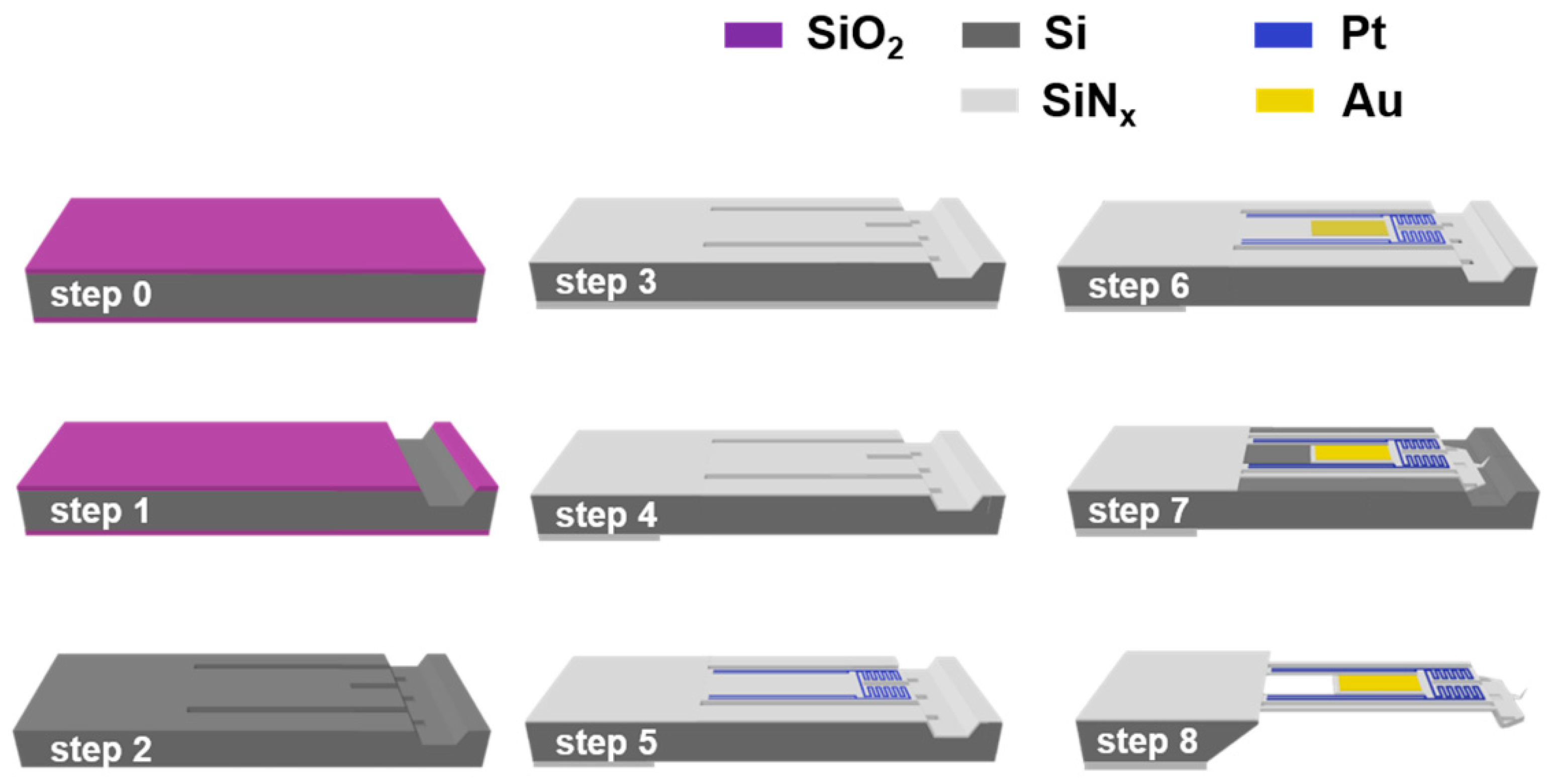
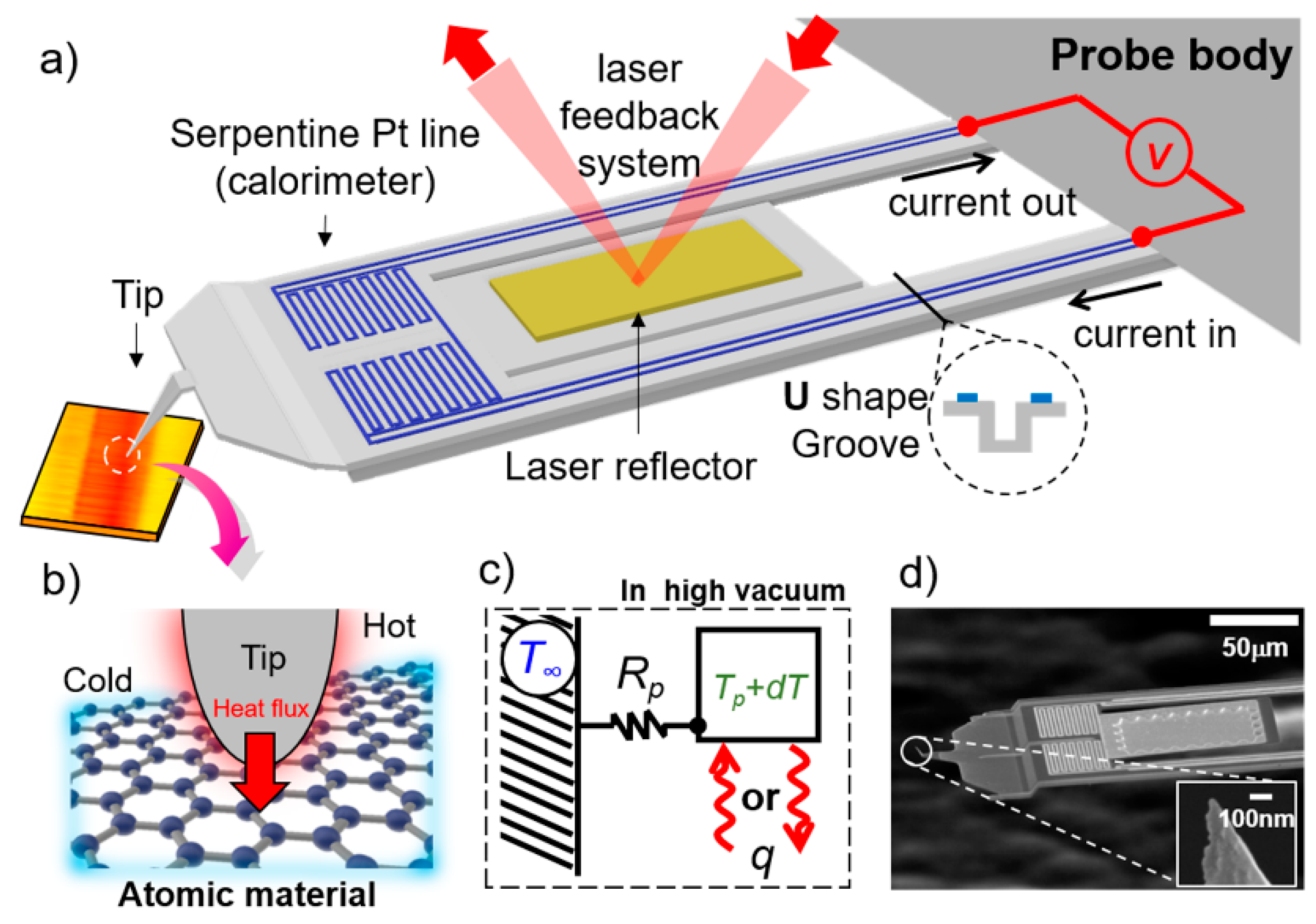
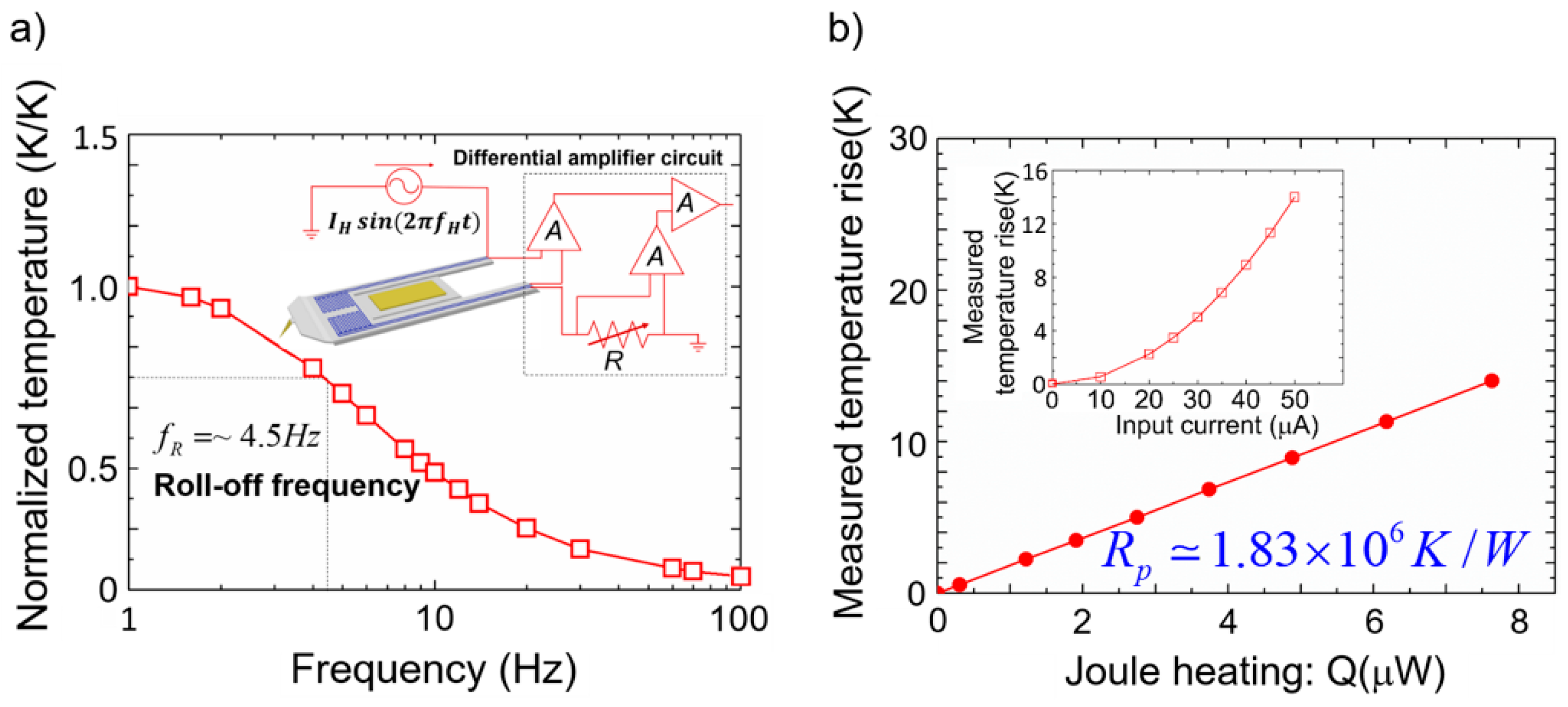

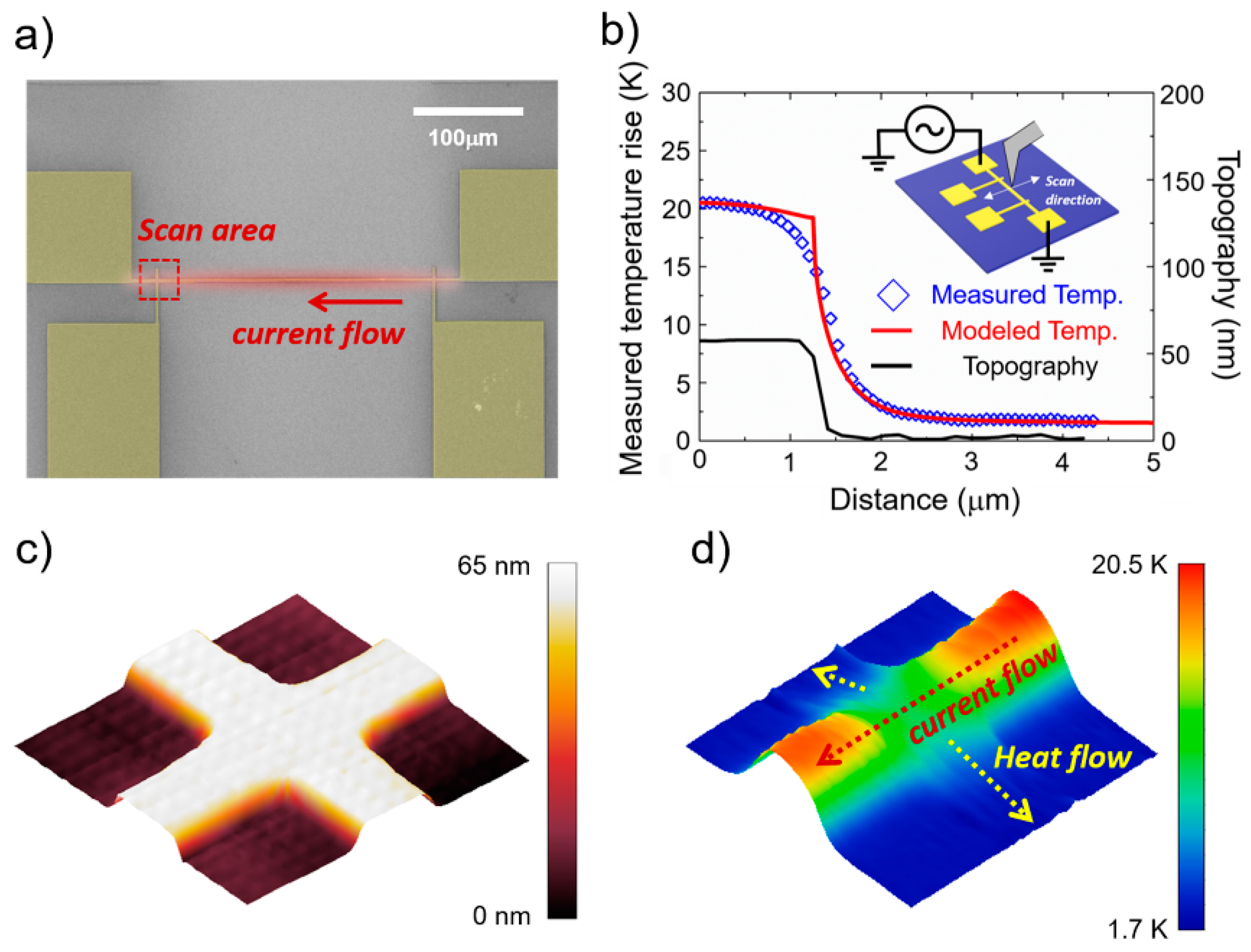
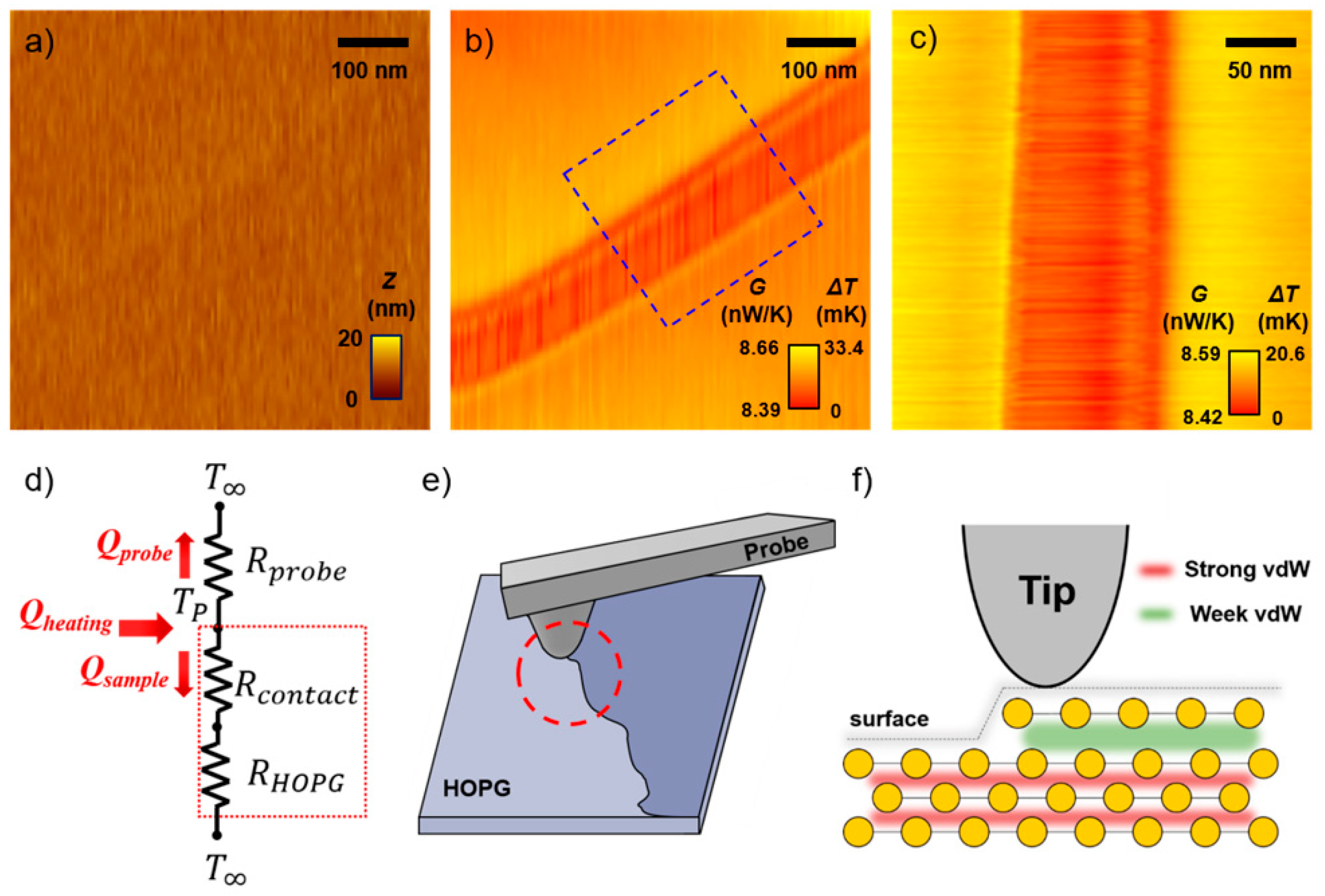
Publisher’s Note: MDPI stays neutral with regard to jurisdictional claims in published maps and institutional affiliations. |
© 2022 by the authors. Licensee MDPI, Basel, Switzerland. This article is an open access article distributed under the terms and conditions of the Creative Commons Attribution (CC BY) license (https://creativecommons.org/licenses/by/4.0/).
Share and Cite
Koo, S.; Park, J.; Kim, K. Pico-Watt Scanning Thermal Microscopy for Thermal Energy Transport Investigation in Atomic Materials. Nanomaterials 2022, 12, 1479. https://doi.org/10.3390/nano12091479
Koo S, Park J, Kim K. Pico-Watt Scanning Thermal Microscopy for Thermal Energy Transport Investigation in Atomic Materials. Nanomaterials. 2022; 12(9):1479. https://doi.org/10.3390/nano12091479
Chicago/Turabian StyleKoo, Seunghoe, Jaehee Park, and Kyeongtae Kim. 2022. "Pico-Watt Scanning Thermal Microscopy for Thermal Energy Transport Investigation in Atomic Materials" Nanomaterials 12, no. 9: 1479. https://doi.org/10.3390/nano12091479





